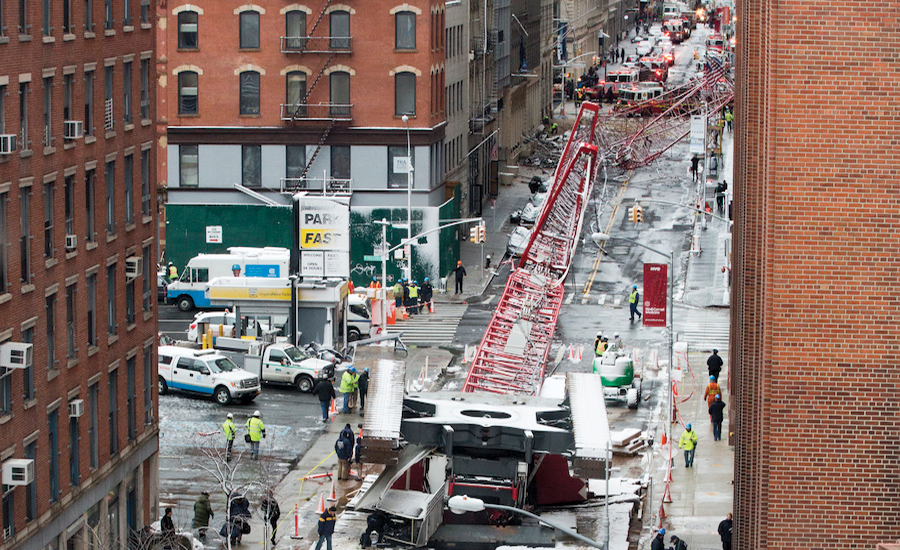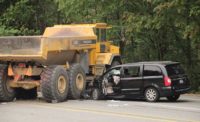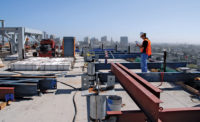On a Friday morning in February, crane operators from Galasso Trucking and Rigging were installing rooftop generators in New York City’s Tribeca area. As wind gusts approached 20 mph, the crew decided to secure the crawler crane’s 565-ft jib and boom. In the process, the crane toppled, crashing onto the street and killing a 38-year-old pedestrian. The accident also hospitalized three others and damaged a water main and gas lines.
All 376 crawler cranes and 53 tower cranes operating in the city were ordered to be locked down. Two days later, Mayor Bill de Blasio announced new regulations that banned cranes rated for wind speeds of less than 20 mph from city streets, including the type that collapsed in the February accident. The mayor’s order also reduced the crane-shutdown threshold to instances when winds are forecast to exceed 20 mph.
Additionally, operators now are required to notify area residents and businesses when cranes are being lowered into a secure position. At the same time, the Dept. of Buildings raised the fine to $10,000 from $4,800 for not complying with cease-operations orders.
“The exact causes of the accident are still being investigated, but there have been no other crane incidents [in the city],” said Alexander Schnell, a DOB spokesman.
A working group that includes Wayne Crew, general secretary of the National Academy of Construction, is part of the investigating team.
While de Blasio acknowledged in his Feb. 8 announcement that Queens-based Galasso Trucking and Rigging operators were following industry best practices—including trying to direct foot traffic away from the area—the mayor saw it as a warning that new measures needed to be enacted. ENR’s calls to Galasso Trucking for comment were not returned.
“There is a construction boom going on in our city, and although we value the work being done, nothing is more important than the safety of our people,” the mayor said during a press conference. “If we have to take strong measures to put limits on construction, we will do so. No building is worth a person’s life.”
DOB statistics show that while the square footage of new construction in the city is up 329% since 2009, accidents have increased 98%, from 218 in 2009 to 433 in 2015. Meanwhile, from 2008 to 2015, the number of jobsite fatalities decreased to 11 from 19. Still, the city has plans to hire an additional 100 enforcement inspectors this summer to investigate accidents and suggest new rules if necessary.
Investigator Bradley Closson, of Bonita, Calif.-based CRAFT Forensic Services, has been contacted as a possible participant in a civil suit related to the case and therefore can’t comment on possible causes of the accident. However, Closson says the subsequent new rules will not necessarily make crane operation in New York City safer.
“Blanket rules on the type of crane that has the lowest accident record for a specific wind speed is not the answer,” he says. “Wind is situational, and the conditions at the ground are not always the same at cab level as at the tip of the boom. That is why you have to expect the people who manage to manage.”
Fall-Protection Changes
New Yorkers aren’t the only ones trying to prevent future accidents by learning from past incidents. Nationally, 4,679 workers were killed on the job in 2014, according to the Bureau of Labor Statistics. That’s nearly 90 per week, or more than 13 deaths every day.
Out of the 4,251 worker fatalities in private industry that year, 874 of those, or 20.5%, were in construction. OSHA reports that the leading cause of worker deaths on construction sites was falls, followed by electrocution, struck by objects, and “caught-in/betweens.” These “fatal four” categories were responsible for more than half (58.1%) of all construction deaths.
These statistics loosely correspond to OSHA’s list of the most frequently cited violations in 2014 and 2015: fall protection, hazard communications, scaffolding requirements, respiratory protection and control of hazardous energy.
OSHA reported six fatal-fall investigations in 2014, including one in January 2014 in which an employee with siding contractor Exterior Recovery Inc., Youngsville, N.C., was on a pump-jack scaffold 49 ft above the lower level, applying commercial siding to a new multifamily apartment building in North Carolina. Unhooking his lanyard to lean toward the building from the scaffold to install a soffit vent, he slipped and fell to his death on the concrete footer below. This incident resulted in one serious OSHA violation and a penalty of $450.
Another incident the same month involved an employee of Skyline Roofing Inc., working at a commercial building in Utah. He was unloading roofing material from a forklift on a roof when he stepped onto a fluted B deck, rolled his ankle, staggered backward, fell over a 1-ft parapet wall and to the ground 36 ft below. This fatality resulted in one repeat OSHA violation and a fine of $6,000. Representatives from the two companies did not respond to ENR requests for comment.
A fall still under investigation occurred in May 2015 at the 20-story, 235,000-sq-ft expansion of the San Francisco Museum of Modern Art. The $305-million project is scheduled to open in June. A year ago, an employee of San Leandro-based Nor-Cal Scaffolding was erecting scaffolding in an elevator shaft when it collapsed on him. He fell 20 ft, to the sixth from the seventh floor.
Jennifer Wycisk, corporate safety director for the general contractor, Webcor Builders, Alameda, says no safety practices changed after the accident. However, new practices “absolutely” often do go into effect after an accident, she notes. Wycisk says that, as a rule, “Webcor tends to use prevention [guardrails] before fall-arrest devices.”
After every accident in California, Cal/OSHA investigates. “Usually, a regulation is already in place that would have prevented the incident, in which case we have six months to issue a citation,” says Eric Berg, deputy chief of research and standards at Cal/OSHA.However, it often takes a year to file a report, he notes, adding, “We can also shut down a site if there is imminent danger, such as when there is an unsafe cave or trench.”
An advisory committee at OSHA’s Standards Board considers whether new regulations are needed. It can take a couple of years to get through the rulemaking procedures, unless administrators consider it urgent and issue a special order. “Usually, it is not one incident but a trend that leads to new rule-making,” Berg says.
A new rule going into effect in California will reduce to 6 ft from 15 ft the minimum height to trigger requirements for fall-protection measures to match federal rules. These measures can include anything from guardrails and safety nets to personal fall-arrest systems and a written fall-protection plan. “Our regulations were already safer than federal regulations because they were more specific and provided more guidelines, but now they will have the same height requirements,” Berg says.
Kevin Cannon, senior director, AGC safety and health services, says that whether existing rules need to be enforced or programs need to be updated, training is a necessary part of the equation to avoid future accidents. “Training is key to preventing many problems. It provides awareness to help contractors identify problems before they happen,” he says.




